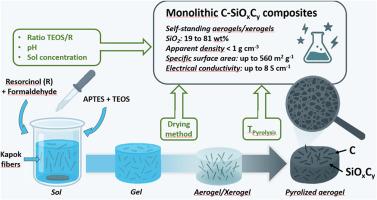Tunable synthesis of C-SiOxCy monoliths
IF 4.7
3区 材料科学
Q1 CHEMISTRY, APPLIED
引用次数: 0
Abstract
This study establishes key structure–property relationships, offering valuable guidelines for designing porous monolithic C-SiOxCy materials for energy storage sensors, and electrocatalysis. We report a tunable sol-gel synthesis of monolithic C-SiOxCy composites with tailored physicochemical and electrical properties. By combining resorcinol, formaldehyde, TEOS, APTES, and kapok fibers, twenty-one formulations were prepared while systematically varying five synthesis parameters: TEOS-to-resorcinol molar ratio, sol concentration, sol pH, drying method, and pyrolysis temperature. The resulting composites exhibited silica contents ranging from 19 to 80 wt%, bulk densities from 0.10 to 1.11 g/cm3, specific surface areas up to 562 m2/g, and electrical conductivities reaching 8 S/cm. Structural analyses (SEM, 29Si NMR, N2 adsorption) revealed that the materials consist of integrated hybrid networks rather than separate carbon and silica domains. Factor analyses highlighted the dominant roles of TEOS/R on composition and porosity, supercritical drying on texture, and pyrolysis temperature on conductivity. Acidic conditions and sol dilution promoted high surface areas and pore volumes, while alkaline pH and carbon-rich environments enhanced electrical transport.

C-SiOxCy单体的可调合成
该研究建立了关键的结构-性能关系,为设计用于储能传感器和电催化的多孔单片C-SiOxCy材料提供了有价值的指导。我们报道了一种可调的溶胶-凝胶合成整体C-SiOxCy复合材料,具有定制的物理化学和电学性能。通过将间苯二酚、甲醛、TEOS、APTES和木棉纤维结合,系统地改变了TEOS与间苯二酚的摩尔比、溶胶浓度、溶胶pH、干燥方式和热解温度等5个合成参数,制备了21个配方。所得复合材料的二氧化硅含量为19%至80%,体积密度为0.10至1.11 g/cm3,比表面积高达562 m2/g,电导率达到8 S/cm。结构分析(SEM, 29Si NMR, N2吸附)表明材料由完整的杂化网络组成,而不是单独的碳和硅畴。因子分析表明,TEOS/R对组分和孔隙度的影响最大,超临界干燥对结构的影响最大,热解温度对电导率的影响最大。酸性条件和土壤稀释促进了高表面积和孔隙体积,而碱性pH和富碳环境增强了电传输。
本文章由计算机程序翻译,如有差异,请以英文原文为准。
求助全文
约1分钟内获得全文
求助全文
来源期刊

Microporous and Mesoporous Materials
化学-材料科学:综合
CiteScore
10.70
自引率
5.80%
发文量
649
审稿时长
26 days
期刊介绍:
Microporous and Mesoporous Materials covers novel and significant aspects of porous solids classified as either microporous (pore size up to 2 nm) or mesoporous (pore size 2 to 50 nm). The porosity should have a specific impact on the material properties or application. Typical examples are zeolites and zeolite-like materials, pillared materials, clathrasils and clathrates, carbon molecular sieves, ordered mesoporous materials, organic/inorganic porous hybrid materials, or porous metal oxides. Both natural and synthetic porous materials are within the scope of the journal.
Topics which are particularly of interest include:
All aspects of natural microporous and mesoporous solids
The synthesis of crystalline or amorphous porous materials
The physico-chemical characterization of microporous and mesoporous solids, especially spectroscopic and microscopic
The modification of microporous and mesoporous solids, for example by ion exchange or solid-state reactions
All topics related to diffusion of mobile species in the pores of microporous and mesoporous materials
Adsorption (and other separation techniques) using microporous or mesoporous adsorbents
Catalysis by microporous and mesoporous materials
Host/guest interactions
Theoretical chemistry and modelling of host/guest interactions
All topics related to the application of microporous and mesoporous materials in industrial catalysis, separation technology, environmental protection, electrochemistry, membranes, sensors, optical devices, etc.
 求助内容:
求助内容: 应助结果提醒方式:
应助结果提醒方式:


